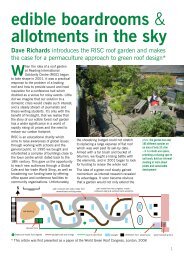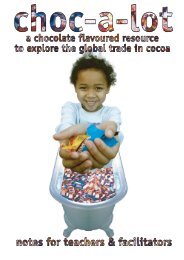Cost of coffee.indd - RISC
Cost of coffee.indd - RISC
Cost of coffee.indd - RISC
Create successful ePaper yourself
Turn your PDF publications into a flip-book with our unique Google optimized e-Paper software.
links in the chain<br />
farmers<br />
D 80% <strong>of</strong> c<strong>of</strong>fee is grown on small farms <strong>of</strong> less than 3 hectares (300x100m – about 3 fullsize<br />
football pitches)<br />
D 25 million families are dependent on c<strong>of</strong>fee for their cash income<br />
middlemen<br />
D growers receive more if they do more processing but farmers may sell beans to ‘middlemen’<br />
– local traders or exporters – at any stage, because their harvest is too small to hire a pickup<br />
to transport beans to the mill or they are too remote to cycle or walk<br />
D farmers can be exploited by these traders who <strong>of</strong>fer low prices because there are few<br />
alternative buyers – small producers <strong>of</strong>ten need immediate cash to pay <strong>of</strong>f debts and do not<br />
have access to information on international prices nor storage facilities to wait for higher<br />
prices<br />
D many farmers get a better deal from cooperatives which provide support to members<br />
– buying and/or processing beans, improving quality through training or laboratory facilities<br />
to test acidity and moisture; some cooperatives supply fair trade roasters directly or sell on<br />
to local exporters<br />
local exporter<br />
D buys, cleans, grades and bags green c<strong>of</strong>fee from producers and transports to coast for<br />
shipping; provides warehousing and ‘bulking’ into 60kg bags for export according to<br />
contracts from dealers<br />
international traders/dealers<br />
D manage the flow <strong>of</strong> c<strong>of</strong>fee to roasters at required quantities, type and grade; important<br />
because c<strong>of</strong>fee is harvested seasonally but demand is steady throughout the year<br />
D six largest traders account for 50% <strong>of</strong> world’s c<strong>of</strong>fee and increasingly involved throughout<br />
the supply chain to increase their pr<strong>of</strong>it margins, with local subsidiaries growing or buying<br />
beans, and processing, grading, transporting and bulking them for export (www.nkg.net,<br />
www.ecomtrading.com, www.volcafe.com)<br />
shipper/importer<br />
D organises and pays for freight costs, insurance, landing charges, import duty, transport to<br />
roaster<br />
roaster<br />
D secure supplies from international traders – no need to hold large stocks because contracts<br />
guarantee supplies <strong>of</strong> different types at short notice – the ‘futures’ markets enables them to<br />
maintain stability in the price they pay for c<strong>of</strong>fee<br />
D roast, blend, grind and package beans; transport to supermarket/c<strong>of</strong>fee bar; advertise to<br />
maintain brand image, market share and pr<strong>of</strong>its<br />
D import duties imposed by ‘developed’ countries on unprocessed c<strong>of</strong>fee are low, but much<br />
higher for processed c<strong>of</strong>fee – this discourages poor countries from developing their own<br />
processing plants and benefitting from higher value-added elements in the c<strong>of</strong>fee chain<br />
supermarket/c<strong>of</strong>fee bar<br />
D retain a high share <strong>of</strong> the price charged to consumers with few major costs or risks<br />
– supermarkets capture about 15% <strong>of</strong> the shelf price<br />
source: Economist Intelligence Unit 2000<br />
13




